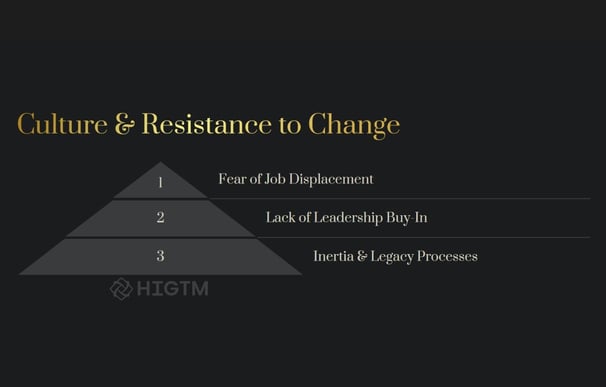15. Barriers to Adoption – Cost, skills, data, culture
Why do so many well-intentioned AI initiatives stall out before driving meaningful returns? Often, the barriers are not purely technological but involve cost constraints, talent shortages, data challenges, and cultural resistance. In this post, we’ll break down each of these four hurdles. You’ll learn why they manifest so frequently and discover practical ways to overcome them. Whether you’re looking to minimize AI project expenses, upskill your team, get a handle on messy datasets, or nurture a culture eager for innovation, understanding these barriers is your first step to unlocking AI’s potential.
Q1: FOUNDATIONS OF AI IN SME MANAGEMENT - CHAPTER 1 (DAYS 1–31): CORE AI CONCEPTS & VALUE PROPOSITION
Gary Stoyanov PhD
1/15/20256 min read

1. Cost & Budget Constraints
When embracing new technology—especially something perceived as complex or risky like AI—financial concerns loom large. For SMEs, limited cash flow or resource allocation can create anxiety about whether the benefits of AI truly outweigh the upfront costs.
1.1 High Upfront Investments
Hardware & Infrastructure: Specialized servers, GPUs, or additional storage may be needed for data-intensive AI solutions.
Software & Licenses: Some AI platforms require substantial subscription fees.
Consulting & Training: Hiring external experts or trainers to guide your organization through AI adoption adds to costs.
Impact: If leadership sees only hefty price tags, they might balk at AI entirely, missing out on incremental improvements that smaller-scale or pay-as-you-go AI solutions offer.
1.2 Operational Costs
Maintenance & Updates: Models degrade over time if they aren’t refreshed with new data, requiring continuous effort or vendor support.
Staff Time: Employees might need to dedicate hours to learning, configuring, or monitoring AI systems—diverting them from core responsibilities.
Impact: Even after go-live, ongoing costs can strain an SME’s resources if not properly forecasted.
1.3 ROI Uncertainty
Longer Timelines: Some AI solutions, particularly advanced analytics or custom machine learning, might take months before you see direct financial returns.
Intangible Gains: Items like improved customer satisfaction or brand reputation are real yet challenging to quantify in terms of immediate revenue.
Impact: Skeptics, including executives or potential investors, may question the wisdom of continuing an AI project if its financial impact isn’t crystal clear from day one.
1.4 Overcoming Cost & Budget Barriers
Low-Code/No-Code Platforms
Minimize large expenditures on specialized talent or infrastructure. Subscription-based solutions often have free tiers or affordable monthly plans.
Phased Rollouts
Start with a modest pilot addressing one department or a small problem. If it proves ROI, expand from there. This approach avoids committing a large budget upfront.
Targeted Pilot Projects
Focus on one high-value pain point. By quickly demonstrating cost savings or revenue uplift, you justify ongoing AI spending.
Creative Funding Sources
Explore grants, innovation vouchers, or local business development programs that encourage tech adoption. In some regions, tax incentives exist for R&D expenditures.
2. Skills & Talent Gaps
Even the best technology fails if your workforce can’t effectively implement or sustain it. AI specifically demands a mix of data engineering and machine learning skills—expertise that’s often in short supply among SMEs.
2.1 Shortage of In-House Expertise
Data Scientists & ML Engineers: Recruiting these roles can be expensive and highly competitive.
AI-Savvy Managers: Mid-level leaders who understand the business implications of AI also play a pivotal role in bridging technical efforts with strategic goals.
Impact: Without the right capabilities, projects might stall, or suboptimal models get deployed—yielding poor insights or user dissatisfaction.
2.2 Competitive Hiring Market
Talent Wars: Larger corporations generally offer higher salaries, more extensive benefits, and brand-name appeal.
Poaching Risk: Even if an SME invests in training an employee to be AI-savvy, they may be lured away by bigger firms.
Impact: SMEs often feel overshadowed in the quest for top-tier data science or AI professionals.
2.3 Upskilling Challenges
Time & Budget: Formal training programs, certifications, or hiring specialized trainers requires financial outlay and staff availability.
Fear of Complexity: Employees may believe AI is too technical, resisting training or feeling anxious about a role shift.
Impact: A learning curve that’s poorly managed can slow or derail AI initiatives, as staff feel overwhelmed or underprepared.
2.4 Overcoming Skills & Talent Gaps
Partnerships & Consultants
External AI consulting can guide initial projects and build internal capacity. Gradually, internal teams learn from these experts, and reliance on outsiders lessens.
Targeted Training & Upskilling
Offer workshops, online courses, or lunch-and-learns focusing on AI fundamentals relevant to each department. For instance, finance staff might learn about AI-based fraud detection.
User-Friendly AI Platforms
No-code or low-code tools mean staff don’t need advanced programming backgrounds. Instead, they configure through intuitive dashboards.
Collaborations with Universities or Tech Communities
Co-sponsor research projects or internships. This can create a talent pipeline while providing fresh perspectives on real-world AI solutions.
3. Data Challenges
AI’s effectiveness depends on data—high-quality, well-organized, comprehensive sets that reflect the real patterns you hope to capture. For many SMEs, “data readiness” proves to be a stumbling block, as scattered records or outdated systems hamper meaningful analytics.
3.1 Data Quality & Availability
Incomplete or Siloed Data: Different departments might keep their own spreadsheets, with mismatched formats or partial duplicates.
Legacy Systems: Outdated or incompatible software can hamper data extraction and consolidation.
Impact: AI models become less accurate or fail outright if they lack consistent, relevant data from across the enterprise.
3.2 Infrastructure & Tools
Data Storage Limitations: Some SMEs rely on basic on-premises servers or even manual methods, complicating large-scale data handling.
Integration Complexities: Combining sales data from e-commerce with operational logs from logistics often demands specialized connectors or APIs.
Impact: Complex or disjointed data pipelines slow progress, making even simple AI tasks resource-intensive.
3.3 Compliance & Privacy
Regulations: GDPR, HIPAA, or other data protection laws create constraints on how personal data is collected, stored, and used.
Security: As data volume grows, so do risks of breaches. SMEs must ensure robust access controls and encryption.
Impact: Fear of compliance failures may prevent SMEs from fully leveraging AI’s potential, or they risk fines and reputational damage if they handle data improperly.
3.4 Overcoming Data Challenges
Data Governance Framework
Establish roles and responsibilities for data ownership, standards for data accuracy, and processes for merging or cleaning data sources.
Gradual Data Cleaning
Start by improving data for a single high-impact AI project. Once proven, expand the cleanup initiative to other data sets.
Leverage Cloud Solutions
Cloud platforms often include built-in tools for data integration, security, and scalability. This lowers overhead for SMEs that can’t invest in extensive on-prem hardware.
Comply Early and Often
If you handle sensitive info (e.g., customer medical or financial data), partner with compliance experts to ensure your AI deployment adheres to legal and ethical standards.
4. Culture & Resistance to Change
Even with budgets, skills, and clean data in place, an organization’s culture can either embrace or reject new tech initiatives. AI often reshapes workflows, roles, and processes—changes that spark fear or skepticism if not managed carefully.
4.1 Fear of Job Displacement
Perception: Employees worry about AI automating tasks entirely, rendering some roles obsolete.
Reality: In many cases, AI offloads tedious tasks, allowing employees to focus on strategic contributions.
Impact: Without transparent communication, staff may become defensive or sabotage AI efforts—leading to subpar adoption.
4.2 Lack of Leadership Buy-In
Perception: Some executives or senior managers view AI as risky, unproven, or unnecessary.
Reality: Their reluctance stifles project resources, limiting scope and halting momentum.
Impact: If top management doesn’t champion AI, it remains stuck in “pilot” mode or languishes with no broad rollout strategy.
4.3 Inertia & Legacy Processes
Perception: “This is how we’ve always done it; AI is a shiny solution searching for a problem.”
Reality: A culture entrenched in legacy processes can be slow to adapt, missing out on innovative use cases.
Impact: Stagnation curtails competitiveness in rapidly evolving markets, leaving SMEs behind more forward-thinking rivals.
4.5 Overcoming Cultural Resistance
Transparent Communication
Explain why AI is being adopted, how it impacts roles, and the potential benefits—like career growth or reduced burnout.
Small Pilot Wins
Start with a departmental project that quickly demonstrates improvements, winning hearts and minds.
Visible Executive Support
Leadership should celebrate AI milestones, highlight success stories, and integrate AI goals into overall business strategies.
Change Management Programs
Offer training, feedback sessions, or even 1-on-1 coaching to help staff adapt. If employees see personal growth opportunities, they’re likelier to champion AI solutions.
5. Key Takeaways & Next Steps
Overcoming the four main barriers—cost, skills, data, and culture—is essential to move from pilot AI experiments to enterprise-wide transformation. Each hurdle can undermine AI’s promise if not tackled proactively. Yet by starting small, focusing on strategic use cases, and sustaining an open, learning-oriented culture, SMEs can confidently embed AI in their operations and position themselves for long-term growth.
Summary of Recommended Actions
Start Small & Build ROI: Choose a narrow, high-impact pilot to prove AI’s value and secure additional investment.
Address Skill Gaps: Combine upskilling programs, user-friendly platforms, and external consulting to fill expertise voids cost-effectively.
Clean & Structure Data: Even basic data governance and modest cloud solutions can dramatically improve model accuracy and maintain compliance.
Champion Change: Leadership must clearly articulate AI’s benefits, invest resources, and set the tone for an adaptive, innovation-friendly culture.
Invitation: If you’re grappling with these barriers—budget constraints, staff readiness, data quality, or cultural resistance—HIGTM offers customized guidance to help your SME break through.
By partnering with our experts, you can chart a structured path toward practical AI deployments that yield measurable returns while respecting your organization’s unique dynamics.




Turn AI into ROI — Win Faster with HIGTM.
Consult with us to discuss how to manage and grow your business operations with AI.
© 2025 HIGTM. All rights reserved.
